NVIDIA GeForce GTX 780 Review: The New High End
by Ryan Smith on May 23, 2013 9:00 AM ESTCompute
Jumping into compute, we should see a mix of results here, with some tests favoring the GK110 based GTX 780’s more compute capable design, while other tests will punish it for not being a fast FP64 card like GTX Titan.
As always we'll start with our DirectCompute game example, Civilization V, which uses DirectCompute to decompress textures on the fly. Civ V includes a sub-benchmark that exclusively tests the speed of their texture decompression algorithm by repeatedly decompressing the textures required for one of the game’s leader scenes. While DirectCompute is used in many games, this is one of the only games with a benchmark that can isolate the use of DirectCompute and its resulting performance.
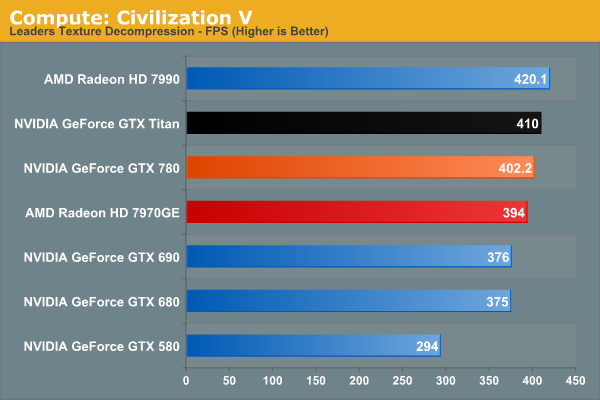
Civilization V’s DirectCompute performance is looking increasingly maxed out at the high end. At 402fps the GTX 780 may as well be tied with GTX Titan. On the other hand it’s a reminder that while we don’t always see NVIDIA do well in our more pure compute tests, it can deliver where it matters for games with DirectCompute.
Our next benchmark is LuxMark2.0, the official benchmark of SmallLuxGPU 2.0. SmallLuxGPU is an OpenCL accelerated ray tracer that is part of the larger LuxRender suite. Ray tracing has become a stronghold for GPUs in recent years as ray tracing maps well to GPU pipelines, allowing artists to render scenes much more quickly than with CPUs alone.
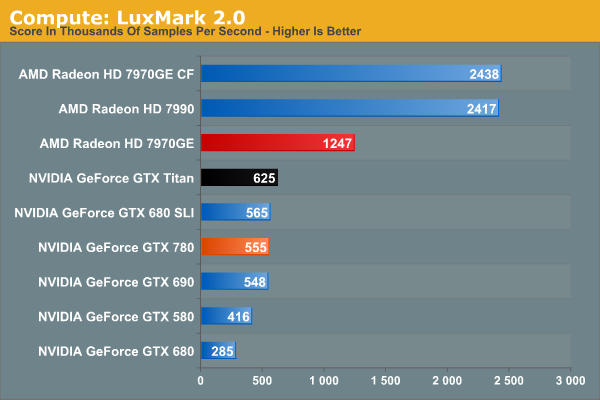
NVIDIA has never done well at LuxMark, and GTX 780 won’t change that. It’s greatly faster than GTX 680 and that’s about it. Kepler parts, including GK110, continue to have trouble with our OpenCL benchmarks, as evidenced by the fact that GTX 780 doesn’t beat GTX 580 by nearly as much as the generational improvements should lead to. GK110 is a strong compute GPU, but not in ways that LuxMark is going to benefit.
Our 3rd benchmark set comes from CLBenchmark 1.1. CLBenchmark contains a number of subtests; we’re focusing on the most practical of them, the computer vision test and the fluid simulation test. The former being a useful proxy for computer imaging tasks where systems are required to parse images and identify features (e.g. humans), while fluid simulations are common in professional graphics work and games alike.
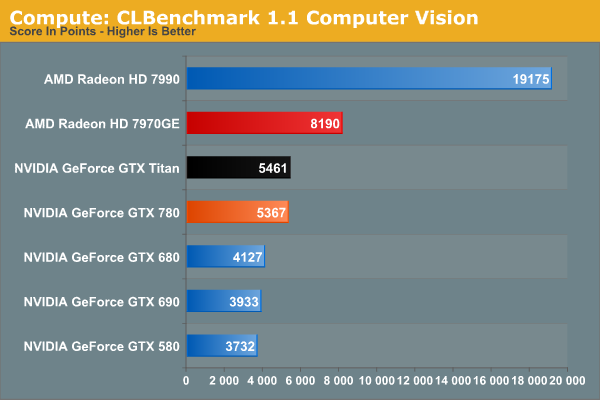
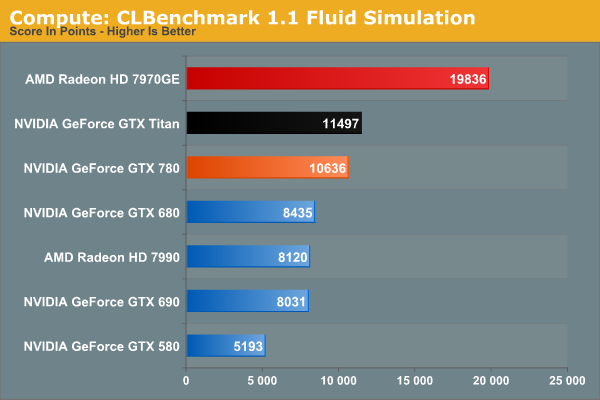
GTX 780 still struggles some at compute with CLBenchmark, but less so than with LuxMark. 7970GE is the clear winner here in both tests, while GTX 780 stays remarkably close to GTX Titan in performance. The fluid simulation in particular makes GTX 780 look good on a generational basis, more than doubling GTX 580’s performance.
Moving on, our 4th compute benchmark is FAHBench, the official Folding @ Home benchmark. Folding @ Home is the popular Stanford-backed research and distributed computing initiative that has work distributed to millions of volunteer computers over the internet, each of which is responsible for a tiny slice of a protein folding simulation. FAHBench can test both single precision and double precision floating point performance, with single precision being the most useful metric for most consumer cards due to their low double precision performance. Each precision has two modes, explicit and implicit, the difference being whether water atoms are included in the simulation, which adds quite a bit of work and overhead. This is another OpenCL test, as Folding @ Home has moved exclusively to OpenCL this year with FAHCore 17.

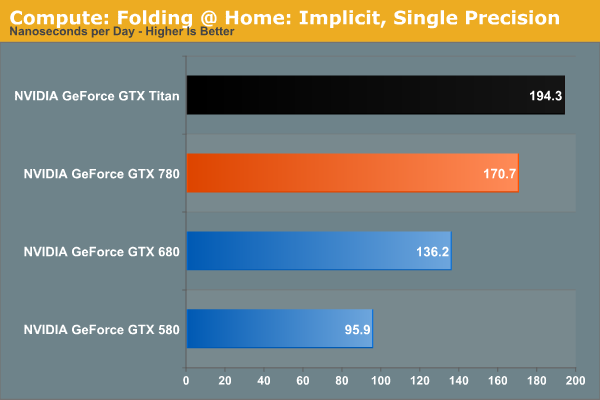
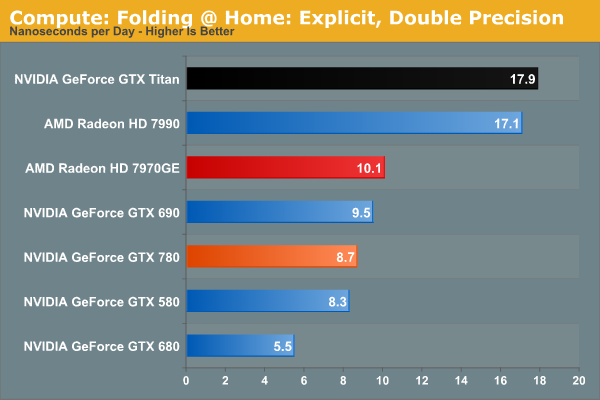
The Folding@Home group recently pushed out a major core update(FAHBench 1.2.0), which we’ve rerun on a number of cards and is reflected in our results. Unfortunately this version also broke single precision implicit on AMD GPUs and AMD’s latest drivers, so we only have NVIDIA GPUs for that section.
In any case, despite the fact that this is an OpenCL benchmark this is one of the cases where NVIDIA GPUs do well enough for themselves in single precision mode, with GTX 780 surpassing 7970GE, and falling behind only GTX Titan and the 7990. GTX 780 doesn’t necessarily benefit from GK110’s extra compute functionality, but it does see a performance improvement over GTX 680 that’s close to the theoretical difference in shader performance. Meanwhile in double precision mode, the lack of an uncapped double precision mode for GTX 780 means that it brings up the bottom of the charts compared to Titan and its 1/3 FP64 rate. Compute customers looking for a bargain NVIDIA card (relatively speaking) will need to stick with Titan.
Wrapping things up, our final compute benchmark is an in-house project developed by our very own Dr. Ian Cutress. SystemCompute is our first C++ AMP benchmark, utilizing Microsoft’s simple C++ extensions to allow the easy use of GPU computing in C++ programs. SystemCompute in turn is a collection of benchmarks for several different fundamental compute algorithms, as described in this previous article, with the final score represented in points. DirectCompute is the compute backend for C++ AMP on Windows, so this forms our other DirectCompute test.
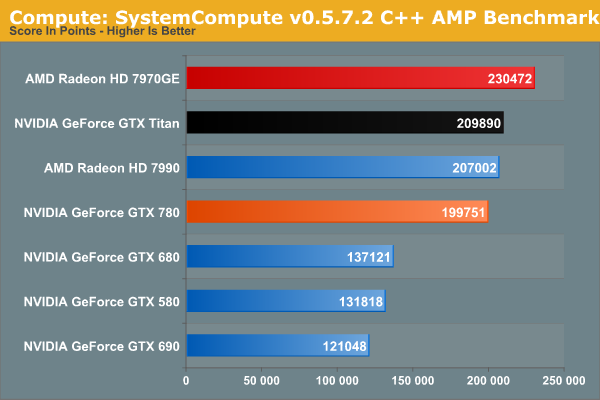
SystemCompute shows very clear gains over both the GTX 680 and GTX 580, while trailing the GTX Titan as expected. However like Titan, both trail the 7970GE.










155 Comments
View All Comments
varad - Thursday, May 23, 2013 - link
You do realize that a GPU like Titan has almost 5 times the number of transistors compared to Intel's biggest Core i7 CPU, right? There are 7.1 billion transistors in Titan vs 1.4 billion in Core i7 3770k. So, it means they cannot match the price of "a good CPU" unless they decide to become a non-profit organization :)AssBall - Thursday, May 23, 2013 - link
Well if all you needed was a single titan to run your is, computations, games, and nothing else, then no problem.krutou - Sunday, May 26, 2013 - link
Two problems with your logic22 nm fabrication is more expensive (price per transistor)
CPUs are more difficult to design
An00bis - Friday, May 31, 2013 - link
it's not like you can just shove your hand in a jar full of transistors and just slap it on a chip and consider it a cpu, a cpu is required to do a gpu's task (integrated gpu) AND be good at everything a gpu can't do, which is... well lots of things actually. A gpu is much simpler, hence why the manufacturing + designing cost is probably more expensive than a big ass card that has to include memory+a pcb+a gpuchizow - Thursday, May 23, 2013 - link
Great card, but a year late. This is what GTX 600 series should've been but we all know how that went.I think Nvidia made some pretty big mistakes with how they handled the entire Kepler generation after Tahiti's launch price debacle. I know their financial statements and stockholders don't agree but they've managed to piss off their core consumers at every performance segment.
Titan owners have to feel absolutely gutted at this point having paid $1000 for a part that is only ~10-15% faster than the GTX 780. End result of this generation is we are effectively paying 50-100% more for the same class of card than previous generations. While the 780 is a great card and a relatively good value compared to Titan, we're still paying $650 for what is effectively Kepler's version of the GTX 470.
Crisium - Thursday, May 23, 2013 - link
People who bought a Titan knew what they were getting into. If you have regrets, you were in no position to buy a $1000 GPU to begin with and made a grievous financial error.$650 isn't horrible for this price, but you are still paying the Nvidia Tax.
chizow - Thursday, May 23, 2013 - link
I don't think so, if you polled GTX Titan owners if they would've paid $1000 knowing 2-3 months later there would be a part that performed similarly at 35% less price, I think you would hear most of them would've waited to buy not 1, but 2 for just a bit more. Or instead of buying 2 Titans, buying 3x780s.Also, it really has nothing to do with being in a financial position or not, it's funny when Titan released I made the comment anyone interested in Titan would be better served by simply investing that money into Nvidia stock, letting that money grow on Titan's fat margins, and then buying 2x780s when they released. All according to plan, for my initial investment of 1 Titan I can buy 2x780s.
But I won't. Nvidia blew it this generation, I'll wait for Maxwell.
IanCutress - Thursday, May 23, 2013 - link
Titan was a compute card with optional gaming, rather than a gaming card with optional FP64 compute. That's why the price difference exists. If you bought a Titan card for Gaming, then you would/should have been smart enough to know that a similar card without compute was around the corner.chizow - Thursday, May 23, 2013 - link
Unfortunately, that was never how *GTX* Titan was marketed, straight from the horses mouth:"With the DNA of the world’s fastest supercomputer and the soul of NVIDIA® Kepler™ architecture, GeForce® GTX TITAN GPU is a revolution in PC gaming performance."
Not to mention the fact Titan is a horrible compute card and value outside of CUDA workloads, and even there it suffers as a serious compute card due to the lack of ECC. It's an overpriced gaming card, plain and simple.
At the time, it was still uncertain whether or not Nvidia would launch more SKUs based on GK110 ASIC, but informed consumers knew Nvidia had to do something with all the chips that didn't make the TDP cut as Tesla parts.
mayankleoboy1 - Thursday, May 23, 2013 - link
Really ? Apart from a few apps, Titan is poor compared to a 7970. It has bad OpenGL performance, which 90% of industry renderfarms use.Titan is really an overpriced gaming card.